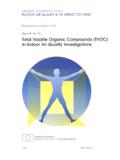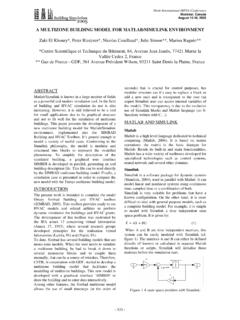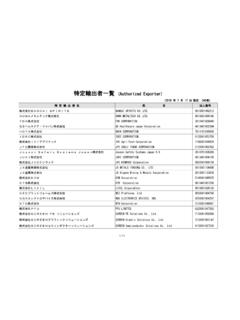Transcription of VOC EMISSIONS FROM WASTE PLASTICS DURING …
1 VOC EMISSIONS FROM WASTE PLASTICS . DURING MELTING PROCESSES. K. Yamashita1 , K. Kumagai1, M. Noguchi1, N. Yamamoto2, 3, Y. Ni4, A. Mizukoshi1, and Y. Yanagisawa1. 1. Graduate School of Frontier Sciences, the University of Tokyo, Chiba, Japan 2. Nursing School of Health Sciences, tokai University, Kanagawa, Japan 3. Japan Society for the Promotion of Science, Tokyo, Japan 4. Earth-Appraisal Co., Ltd, Tokyo, Japan ABSTRACT. Hazardous compounds emitted DURING the plastic melting process were analyzed to indicate potential air pollution issues associated with recycle plants for WASTE PLASTICS .
2 These hazardous compounds might be not only from polymer degradation but also from additives and print ink. To confirm what are emitted from them, melting experiments were conducted (150, 200 and 250 C, in air or N2) and volatile organic compounds (VOCs) emitted from samples were trapped by Tenax/Carboxen adsorption tubes and analyzed by TD-GC/MS. In the present study, virgin polymers such as low-density polyethylene (LDPE), polypropylene (PP), polystyrene (PS) and reproduced plastic were tested. As a result, higher temperature caused more emission of VOCs. Moreover, less VOCs and less oxygenated organic compounds which were said to be hazardous to human and the cause of bad odor were emitted in N2.
3 Atmosphere than in air. Based on these results, lower temperature and lower oxygen level are preferable to reduce hazardous compounds DURING the plastic melting process of mechanical recycling. KEYWORDS. WASTE PLASTICS , Recycle, Melting, Emission, Hazardous compounds INTRODUCTION. The issues related to plastic wastes have been a serious environmental problem for a long time and one measure is recycling. In Japan, according to Fundamental Law for Establishing a Sound Material-Cycle Society and Law for the Promotion of Sorted Collection and Recycling of Containers and Packaging (known as the Container and Packaging Recycling Law) enacted by the Japanese Ministry of the Environment, recycling is required for WASTE PLASTICS by mechanical process.
4 In this mechanical process, WASTE PLASTICS are melted and then recycle products are manufactured. Additionally, the amount of PLASTICS recycled by this process has increased year-by-year, so mechanical recycling will become more and more important in the future. Meantime, hazardous compounds might be emitted DURING the melting process. Therefore the workers in the mechanical recycling plant as well as the residents living near the plant might be exposed to them. First, these hazardous compounds are thought to come from degradation of polymer chains. Heat produces radicals within the polymer chain, the degradation proceeds rapidly and then products enough to volatile are emitted from the plastics1.
5 In air, the reaction proceeds more rapidly and . Corresponding Author: Tel: +81-4-7136-4712, Fax: +81-4-7136-4712. E-mail address: oxidative products such as aldehydes and/or ketones are formed. To date, many studies were conducted to investigate EMISSIONS of volatile compounds from the PLASTICS DURING the melting process2-6. Almost all reports indicated that the compounds from the process are products by polymer degradation. When WASTE PLASTICS were melted, other compounds originated from various factors such as additives besides the polymer degradation would be emitted. In this study, virgin plastic pellets including low-density polyethylene (LDPE), polypropylene (PP) and polystyrene (PS) and WASTE plastic pellets were investigated.
6 Besides the polymer degradation, the effects of additives and other materials in these PLASTICS were also investigated. The aims of this study are to clarify the species and the amount of compounds emitted in air or N2 atmosphere and at several temperature DURING the melting process of plastic mechanical recycling and to suggest using an anoxic atmosphere to reduce emission of these compounds. EXPERIMENTAL. Sample Three kinds of commercially available virgin plastic pellets were used: LDPE (NOVATEC Injection grade LD802, Japan Polyethylene Corporation), PP (NOVATEC Injection grade MA3, Japan Polypropylene Corporation) and PS (GPPS HF77, PS Japan).
7 These are three major dumped polymers in Japan7. The WASTE plastic pellets obtained from the containers and packaging facility (Kashiwa Ecoplaza) were also used. Experimental apparatus The experimental apparatus is shown in Figure 1. The sample pellets were placed in a tubular furnace (Ceramic Tubular Furnace ARF Series, Asahi Rika Corporation) with a temperature controller (Digital Temperature Controller AMF-N, Asahi Rika Corporation) and heated at the controlled temperature in air or N2. The gas flow was 300 mL/min. At the downstream of the furnace, the line was branched into 2.
8 Directions, and an ATD tube (referred to hereinafter) was connected to one of the following lines. VOCs contained in the out gas were collected via the tube pumped at 100 mL/min (Pocket Pump 210-1002, SKC) for 10 min. Prior to sampling, 2-min preheating was conducted. Thermocouple Thermal Controller Sample Air or N2 ATD tube Adsorbent . Mass Flow Tubular Controller Furnace Pump Figure 1. Experimental apparatus Adsorbents ATD tubes (PerkinElmer) filled by 100 mg of Tenax TA (Tenax TA 60/80 mesh, Analytical Columns) and 70 mg of Carboxen 1000 (Carboxen 1000 60/80 mesh, SPELCO) were used for sampling.
9 The tubes were preheated at 320 C for 3 hr in N2 flow. Experimental condition In this study, we aimed to qualitatively and quantitatively clarify the volatile compounds from the polymer. To investigate the effect of temperature on emission of volatile compounds, LDPE was heated at the temperature of 150, 200 and 250 C. This temperature range was set on the assumption of operational conditions. The species of volatile compounds emitted from LDPE, PP, PS and WASTE PLASTICS in both air and N2 atmosphere at the temperature of 200 C were characterized. g of plasic pellets were tested.
10 The corresponding number of virgin plastic pellets was 12, 14 and 14 for LDPE, PP. and PS respectively, whereas heterogeneous WASTE plastic pellets were tested around grams. Triplicate measurements were performed for each plastic and experimental condition. Analytical method The ATD tubes after sampling were analyzed by thermal desorption-gas chromatography/mass spectrometry (TD-GC/MS). An analytical condition is shown in Table 1. The substances trapped by adsorbents are desorbed by TD (TurboMatrix650, PerkinElmer) and then analyzed by GC (6890 Series GC System, Agilent) and MS (5973 Network Mass Selective Detector, Agilent).





